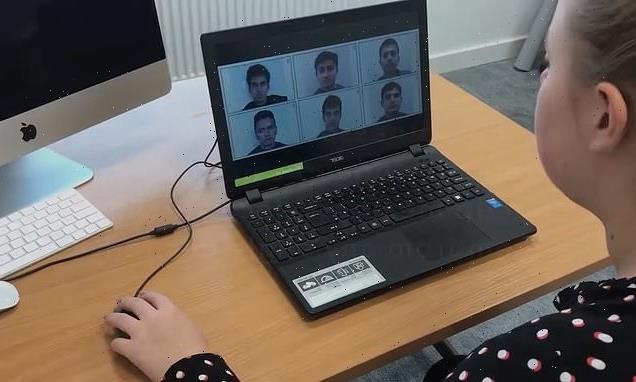
Is THIS the key to improving eyewitness identification? Interactive police line-ups that show 3D images make it easier to identify perpetrators, study finds
- New software lets witnesses rotate and view line-up faces from different angles
- In trials it boosted correct identification of guilty suspects by 18 per cent
- The academics are now recruiting volunteers for the next stage of their research
Interactive online police line-ups that show 3D images of people’s faces can make it easier to accurately identify perpetrators, a new study reveals.
Experts at the University of Birmingham have been testing a new type of software that lets witnesses move a line-up of faces in several directions.
In trials, eyewitnesses who used the software were able to identify perpetrators more accurately when able to manipulate the 3D images of the suspects.
Compared to static photographs, interactive line-ups boosted the correct identification of guilty suspects by 18 per cent.
POLICE LINE-UPS
Line-ups are used around the globe to help police identify criminals.
Typically these involve witnesses examining an image of the suspect alongside ‘fillers’ – individuals who look similar, but who weren’t involved in the crime.
Eyewitness may have to identify the perpetrator if the perpetrator is present in the line-up (known as a correct identification) or to identify no one if the perpetrator is absent from the line-up (known as a correct rejection).
The ability of the eyewitness to accurately identify guilty from innocent suspects is known as discrimination accuracy.
Researchers report that allowing witnesses to view suspects at from different angles using software increases discrimination accuracy.
The software could benefit several countries, like the US, Germany, Canada and Australia, where line-ups consist of static photos, instead of face-to-face viewings, known as a ‘live ID’, as well as in the UK.
In the UK, lineups are conducted in identification suites, where witnesses watch video identification parades on a computer screen, rather than a live ID.
‘Live IDs are not used because they are expensive and difficult to organise,’ study author Professor Heather Flowe told MailOnline.
‘It could be hard to find people who match the witness’ description of the perpetrator.’
The software, developed and tested at the University of Birmingham’s School of Psychology, lets witnesses rotate and view line-up faces from different angles.
Users can ‘dynamically view the line-up faces from -90 degrees to 90 degrees and hold the faces in any pose desired’.
For the study, researchers recruited more than 3,000 volunteers who acted as ‘witnesses’ to test how well they could identify a fake suspect using the software.
The volunteers watched a video of a staged crime being committed – a man stealing a handbag from behind a female victim – and were then shown images of the perpetrator, alongside ‘filler’ images of similar faces.
When the eyewitnesses were able to rotate the image to match the alignment of the perpetrator’s face in their memory, they were more likely to accurately pick out the criminal from the line-up.
Accuracy was the highest when participants rotated the line-up faces to match the angle of the perpetrator as he or she had appeared in the video, the researchers found.
Researchers also found that the witnesses moved the images into the best position for identification ‘naturally’ – without instruction.
‘This suggests that people – consciously or unconsciously – value the information that can be gleaned from reinstating pose when making an identification decision from a line-up,’ the team say.
Researchers report that allowing witnesses to view suspects from different angles using software increases something called ‘discrimination accuracy’ – the ability to pick out the perpetrator from the ‘filler’ and avoid misidentification.
According to the US-based Innocence Project, misidentification is the single greatest cause of wrongful conviction in the United States.
According to the US-based Innocence Project, misidentification is the single greatest cause of wrongful conviction in the United States (stock image)
Since 1989, 365 wrongful convictions in the country have been overturned on the basis of new DNA evidence, and the reliance on inaccurate eyewitness testimony played a role in securing convictions in many of these cases.
‘We worked closely with law enforcement to develop the interactive line-up procedure to be cost-effective and work with current police identification systems,’ said Professor Flowe.
‘The procedure is a significant advance in improving the accuracy of eyewitness identifications.’
The University of Birmingham team is now recruiting participants for the next phase of its eyewitness memory research.
Their study, ‘Perpetrator pose reinstatement during a line-up test increases discrimination accuracy’, has been published in Scientific Reports.
Burglars beware! Scientists have discovered a way to collect human DNA from the AIR around us
Animal and human DNA can be collected from the air in a room, according to scientists reporting in the journal PeerJ in 2021.
Air sucked from a room and pumped through an ultra-fine filter was able to capture DNA shed by a person’s body, called environmental DNA (eDNA).
If a criminal is suspected to have passed through a crime scene, analysing the air could reveal their DNA and therefore, their identity.
Environmental DNA has previously been detected in water, soil and snow and used as a way of studying fish, animals and invasive species.
The study was led by Dr Elizabeth Clare, a senior lecturer at Queen Mary University of London
‘Here we provide the first published evidence to show that animal eDNA can be collected from air, opening up further opportunities for investigating animal communities in hard to reach environments such as caves and burrows,’ Dr Clare said.
Read more: Scientists collect human DNA from the air
Source: Read Full Article
